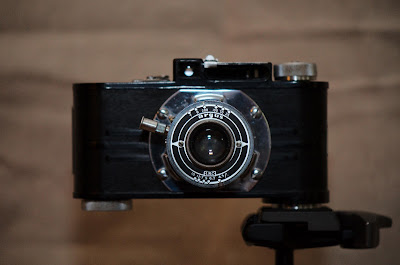The shutter is a set and release Flash Kodamatic with speeds from 1/2 to 1/200 second plus bulb and time. You cocked the shutter by pulling the shutter release lever up and took a picture by pushing the shutter release lever down. The shutter is synchronized for flashbulbs. The ASA bayonet post for the flasholder is to the photographer's left. You needed to cock the synchronizer after you cocked the shutter to use flash. The purpose of the synchronizer was to delay opening the shutter until the flash bulb approached peak brightness, which took about 20 milliseconds.
The camera will take twelve 2-1/4" square pictures on a roll of 620 film. You can't squeeze a 120 roll into the camera, but you can use currently available 120 films by respooling the 120 film onto a 620 spool. A film reminder dial is on the winding knob. You count exposures and space your pictures by looking through the classic ruby window on the back of the camera at numbers printed on the backing paper of the film. The ruby window has a cover to keep out stray light that could fog the film. You open the cover only when advancing film. There isn't any double exposure prevention. Kodak recommended always advancing the film immediately after taking a picture.
The original list price was $100 in 1946, or about $1,270 in depreciated 2018 dollars. It was not a cheap camera. I would call it roughly the equivalent of a contemporary Rolleicord - a high end photo hobbyist camera.
Some changes were made during the production run. The lenses on the first cameras were marked "Kodak Anastigmat" while the lenses on later cameras were marked "Kodak Anastar". The lenses didn't change, only the name. The flash synchronizer was changed, and the winding knob was made a little taller. Some cameras were made with metric distance scales.
Front
Back
Top
Bottom
Left
Right







































